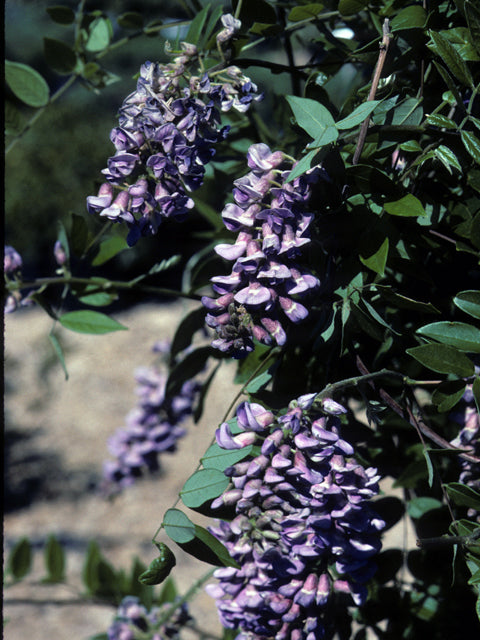Texas Wisteria (Wisteria frutescens)
Texas Wisteria (Wisteria frutescens)
Low stock: 10 left
Couldn't load pickup availability
Wisteria frutescens (L.) Poir.
American Wisteria, Texas Wisteria, Kentucky Wisteria
Fabaceae (Pea Family)
Synonym(s): Kraunhia frutescens, Kraunhia macrostachya, Wisteria frutescens var. macrostachya, Wisteria macrostachya
USDA Symbol: WIFR
American wisteria is a high-climbing woody, deciduous vine, 25-30 ft. long. Shiny, dark-green, pinnately compound leaves bear 9-15 leaflets which are opposite on the leaf stem, with 1 leaflet at the tip. The flowers are in large, drooping clusters 6-9 inches long that appear after the plant has leafed out, a difference from the popular Asian species. The blooms only appear on new wood. Individual flowers are nearly 1 inch long and are lilac or bluish purple and quite fragrant. A brown, bean-like pod persists until winter. This species is less aggressive than the similar Asian species.
Plant Characteristics
Habit: Vine
Leaf Retention: Deciduous
Leaf Arrangement: Alternate
Inflorescence: Raceme
Fruit Type: Legume
Size Notes: 25-30 feet.
Leaf: Green
Flower: Flowers in 4 to 6 inch flower clusters
Fruit: Brown 2 to 4 inch pod
Bloom Time: May , Jun
Bloom Notes: Usually lavender blue in color, but occasionally white. Blooms only on new wood.
Distribution
USA: AL , AR , CT , DE , FL , GA , IA , IL , IN , KY , LA , MA , MD , MI , MO , MS , NC , NJ , NY , OH , OK , PA , RI , SC , TN , TX , VA , WVNative Distribution: Eastern US as far west as east Texas, Zones 5 to 8
Native Habitat: Moist or wet woods; river banks; upland thickets
Growing Conditions
Water Use: MediumLight Requirement: Sun , Part Shade , Shade
Soil Moisture: Moist
Soil pH: Acidic (pH<6.8) , Circumneutral (pH 6.8-7.2)
CaCO3 Tolerance: Low
Drought Tolerance: Medium
Soil Description: Rich, moist to mesic, neutral to slightly acid soils. Sandy, Sandy Loam, Medium Loam, Clay Loam, Clay.
Conditions Comments: Prefers a good loamy soil in a sunny south or southwest facing position, sheltered from cold winds and from early morning sun on frosty mornings. Plants can become chlorotic on alkaline soils. Prefers a rich soil, but some gardeners feel too rich a soil results in too much leaf growth. Tolerates seasonal flooding.
Benefit
Use Ornamental: A lovely, aromatic Wisteria native to eastern North American that is less aggressive and less damaging to buildings than the Asian species, but has equally lovely flowers. Can be trained on arbors, walls, and columns.Conspicuous Flowers: yes
Fragrant Flowers: yes
Attracts: Butterflies
Larval Host: Marine Blue, Zarucco Duskywing, and skippers
Nectar Source: yes
Deer Resistant: High
https://www.wildflower.org/plants/result.php?id_plant=WIFR
Image Information
Photographer: Wasowski, Sally and AndyAccession date: 2006-07-25
Filename: SAW_03998.JPG
Slide Index: W11444
Restrictions: Unrestricted
Collection: Wasowski Collection
Original Format: 35 MM
Orientation: Portrait
Shot: Flower(s)
Date Taken: 1988-04
NPIN Image Id: 25047


